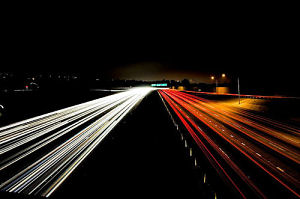Have you ever seen photographs of vehicle lights on the freeway or abstract images of beams of light? They’re both examples of what is called a “long exposure.” That is, a photograph with a slow (long) shutter speed. You just need two things to make these kinds of photographs:
- a camera that allows you to manually set the shutter speed (called “Shutter Priority” mode, it is sometimes noted on cameras with the symbol “Tv”) and that allows shutter speeds longer than 1 second.
- a stable platform to hold the camera steady
Why does the camera need to be held steady? When the shutter is open for longer than about 1/30 of a second, the image starts to become blurry due to camera shake. The minute motions of your hand as you hold the camera make the image blurrier the longer the shutter is open. An excellent platform for this kind of work is a tripod. A good, sturdy tripod is a great tool but you can get by without one. A rock, the ground, a ledge, a trash can — anything that the camera can be set on top of that isn’t going to move can be used as an ad-hoc tripod.

15s @ f/14
Making these types of photographs takes some experimentation. This is one area where digital and the ability to instantly preview your captured image really shines. If you don’t get what you want, just hit the delete button and try again. You’ll use different shutter speeds to capture different scenes depending on the effect you want and the available light. After you do it a few times you’ll start to get a feel for it.
Compose the image and focus as you normally would. Once you’ve got the scene you want in your viewfinder, it can be helpful to put the camera into manual focus mode so that you don’t have to re-focus for every shot. Then start by setting your camera to something like 2 seconds. Carefully press the shutter without shaking the camera or use a cable shutter release or wireless remote if you have one (or even the camera’s self-timer). When the time is up, review the image and see what you’ve got. If you’re trying to capture light trails, the longer the exposure, the longer the trails will be.

8s @ f/13
A neat trick with a long exposure shot is that anything that is moving quickly through the frame will only be partially visible and sometimes won’t be captured at all. You can make interesting photos taking advantage of this effect by walking through the frame while waving a flashlight, for example. A flashlight can also be used to illuminate an object (even yourself) moving through the frame at intervals so that it appears to be in more than one location simultaneously.









0 comments